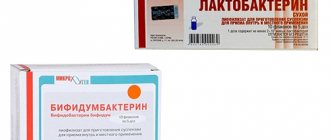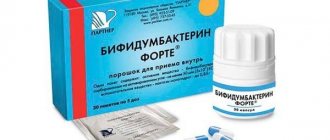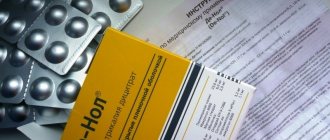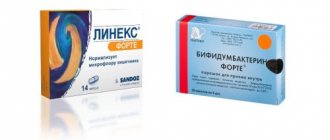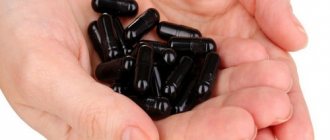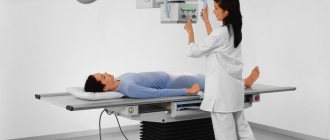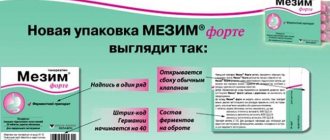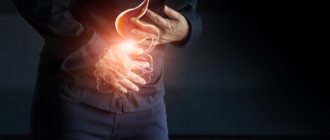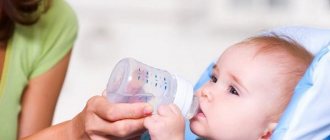After birth, the child experiences adaptation of the digestive tract to the new conditions of postnatal development. This is manifested by colic, constant regurgitation, bloating and accumulation of gases in the abdomen. All this leads to the fact that the child sleeps poorly and gains weight. To eliminate these unpleasant symptoms, doctors recommend giving newborns Bifidumbacterin.
Bifidumbacterin in vials can be given to children from the first days of life
Pharmacological properties
Bifidumbacterin is a probiotic that is an antagonist of a large number of pathogenic and opportunistic intestinal microorganisms, such as:
- Staphylococcus aureus;
- shigella;
- salmonella;
- Escherichia coli;
- Proteus;
- Klebsiella;
- a number of yeast-like fungi.
It normalizes the microflora of the intestines and vagina, digestion in the intestines, activates metabolism, and increases the nonspecific resistance of the body.
Normal intestinal microflora is a natural biosorbent that decomposes toxins entering from the outside or synthesized in the body into non-toxic components; it takes part in the synthesis of some vitamins (cyanocobalamin, folic acid, vitamin K).
Indications and contraindications
Indications
Bifidumbacterin is prescribed to newborns:
- for the prevention and treatment of dysbiosis of the digestive tract caused by various reasons, including stomach and duodenal ulcers, inflammation of the liver, pancreas, gall bladder, allergies, taking antibiotics, hormones, non-steroidal anti-inflammatory drugs, stress, radiation and chemotherapy;
- to prevent the development of hospital infections and dysbiosis in children who often suffer from acute respiratory viral infections;
- for the prevention of disturbances of intestinal microflora before and after surgical treatment of the digestive organs;
- with early transfer of the baby to artificial feeding;
- weakened children who have anemia, rickets, protein-energy deficiency, allergic diathesis;
- if infectious and inflammatory diseases are observed in infants, such as pneumonia, purulent-septic processes.
Useful article? Share the link on VKontakte
In addition, Bifidumbacterin is prescribed to newborns if the child has:
- acute intestinal infections, including those caused by rotaviruses, Shigella, Salmonella;
- food poisoning, including those caused by staphylococci;
- chronic stool disorder or constipation that developed due to prolonged use of antibiotics;
- malabsorption syndrome.
Contraindications
Bifidumbacterin should not be prescribed to a newborn if he has an individual intolerance to the drug. In this case, an allergic reaction may occur, which requires stopping the medication and immediately contacting a doctor to prescribe antiallergic drugs and further adjust the treatment regimen.
Important! Some dosage forms of Bifidumbacterin may contain lactose, so they are contraindicated in children suffering from lactase deficiency.
With this disease, the body cannot digest dairy products. It can be manifested by upset stools; they become liquid, foamy, and have a sour odor. A newborn may experience anxiety during or immediately after feeding, bloating, colic, and poor weight gain. All these symptoms are not specific and can develop with other diseases of the digestive tract, including dysbacteriosis. That is why Bifidumbacterin can be given to a newborn only if it has been prescribed by a doctor. Only a doctor can determine the need for its prescription, as well as select the correct dosage.
Similar drugs
If there is an allergy to the components of Bifidumbacterin or hypolactasia in an infant, it is recommended to replace the drug with a safer one. The pharmaceutical market offers medications with similar effects:
- Bifiform;
- Probifor;
- Bifinorm;
- Biolact and others.
These are drugs based on living bifidobacteria that inhibit the development of pathogens.
Many parents are interested in the question of which is better - Lactobacterin or Bifidumbacterin. Both drugs are probiotics based on living microorganisms. Only Lactobacterin contains lactobacilli, and Bifidumbacterin contains bifidobacteria. Probiotics act in almost the same way, but the latter drug is more often prescribed to infants, since there are more bifidobacteria in their intestines. The doctor will help you choose the right medicine and advise you on how to take it.
According to reviews, Bifidumbacterin labeled “Forte” is more effective, since it contains bifidobacteria adsorbed on activated carbon particles. The drug penetrates the digestive tract and exhibits a therapeutic effect faster.
Thus, Bifidumbacterin is an effective and safe probiotic agent that restores the intestinal microbial flora, normalizes digestion, and improves immunity. However, in order to avoid negative effects before using the drug, carefully study the contraindications. Bifidumbacterin is contraindicated in case of allergies to its components and hypolactasia
It is important to follow the dosage and treatment regimen determined by the pediatrician
Subscribe to our VKontakte group
Rules for taking Bifidumbacterin
Bifidumbacterin is available in several dosage forms:
- in bottles and ampoules in powder form for the preparation of a solution for oral administration and topical use;
- in sachets, which also contain powder for the preparation of a solution for oral administration and topical use;
- in vaginal or rectal suppositories, allowed for use in children over 3 years of age;
- in tablets, it is also acceptable to use in children who are already 3 years old, in the case when the child can swallow the tablet.
Bifidumbacterin can be given to a newborn in powder form.
Important! Despite the fact that Bifidumbacterin is sold without a prescription, it can only be given as prescribed by a specialist.
Only a doctor can prescribe a drug after examining the child and familiarizing himself with stool tests, so when a newborn has problems with the digestive tract, you should immediately seek medical help. This will help avoid progression of the disease. You should also not interrupt the course of taking the medication on your own. In addition, the doctor can tell which Bifidumbacterin is best for newborns.
Before giving medication to a child, you need to know how to dilute Bifidumbacterin.
If the baby is bottle-fed, then the powder must be mixed with the liquid part of the food, preferably something made from fermented milk or boiled water at room temperature. For breastfed babies, the lyophilisate can be diluted in breast milk. The volume of liquid can vary from 30 to 50 ml, unless of course the doctor prescribes other proportions for dilution.
Important! The dilution liquid should not be higher than 40 degrees, otherwise the living bacteria will die.
The medicine is given 20-30 minutes before meals, and it is also possible to give it to the child right before feeding.
Some parents whose children do not suck a bottle do not know how to give Bifidumbacterin to a newborn. This can be done simply: even premature babies who are unable to breastfeed can drink from a spoon. If parents are afraid to give medicine in this way, then they can give it from a pipette or from a syringe. To do this, you need to disconnect the needle, it will not be needed, draw the medicine into the syringe and give it drop by drop or carefully pour it into the child’s mouth.
If the child does not suck a bottle, you can give him Bifidumbacterin using a syringe
The duration of therapy is determined by the doctor individually, usually the preventive course varies from 7 to 10 days, and for therapeutic purposes the drug is prescribed for 17-20 days; after a month's break, Bifidumbacterin can be prescribed by the doctor again.
Important! Once Bifidumbacterin is diluted, the prepared solution cannot be stored. Undiluted lyophilisate should be stored in the refrigerator at a maximum temperature of 10⁰C. The shelf life of the medicinal product is 12 months; after its expiration, the medication cannot be taken and must be disposed of.
It must be remembered that Bifidumbacterin for oral administration should not be taken while taking antibiotics, as they reduce the effectiveness of treatment.
But the effects of Bifidumbacterin are enhanced if taken in parallel with vitamins, especially when taken with B vitamins.
If you follow all the doctor’s recommendations, the newborn’s condition should improve in a week: stool and digestive tract function will normalize, the amount of gases will decrease, and bloating will go away.
If after this time the child does not feel better, then you need to consult a doctor to adjust the treatment regimen.
Bifidumbacterin for newborns and infants: instructions for use
The word “dysbacteriosis” is known to all mothers.
The impression is that none of the babies born can survive without this phenomenon, which means a lack of necessary enzymes in the intestines for timely and high-quality digestion of food.
Quite a lot of means have been invented to eliminate this negativity. Bifidumbacterin is recognized as one of the most effective drugs, which helps normalize children's digestion and saves from colic in newborns.
Scheme and course of application
Tablets are not used for infants.
Packages and ampoules are used most often, so it is their use that we will consider.
Powder
This form, prescribed by pediatricians, is the most common. The reason is simple: containing a complex of pure lactose with dry bacteria, the powder is easily diluted and is quickly ready for use.
Important! Lactose in this composition is intended to stimulate the growth of bifidobacteria. In addition, the resulting solution will not cause additional irritation to the child, since it is colorless, tasteless and odorless.
Mommy won’t have to rack her brains trying to figure out how to give Bifidumbacterin powder to a newborn - everything is written in the instructions and the doctor will explain.
There are three recommended times when the medicine is given to the baby:
- When he's hungry.
- 30 minutes before feeding.
- An hour after the child has eaten.
For infants, it is not an aqueous solution, but a milk solution of Bifidumbacterin. This also applies to “artificial” ones, in the sense that the drug is diluted along with mixtures. Dosage: three times a day, one packet of powder for a child under six months of age. Standard course - 3 weeks. It is repeated another month.
For dysbacteriosis, an older child is prescribed a daily dose of one sachet of powder for 7-10 days. The basis of the solution is already boiled water.
Having diluted the powder with 5 ml of water, as required by the instructions, add another teaspoon into the resulting mixture (otherwise it will be impossible to drink) - readiness for use is indicated at the moment the substance is completely dissolved.
In ampoules
The peculiarity of the beneficial microbes contained in the liquid of the ampoules is that these vacuum-dried bacteria are treated with a special feeding medium in the form of jelly.
Each ampoule contains 5 doses of the drug. it is applicable for kids of any age. Now let’s talk about how to actually dilute bifidumbacterin for newborns, contained in ampoules.
in fact, there are no significant differences from the “powder” version. After opening the ampoule, its contents are converted into a solution with the help of water, breast milk or artificial formulas, which is intended for the child. 5 ml of liquid is provided per dose, therefore, 25 ml of liquid is needed per ampoule. the medicine is fed to him with a spoon.
dosage: children under six months of age in the first four days of the course are given 1-2 doses (1-2 teaspoons of solution) twice a day. in the future, the dose can be increased if the pediatrician agrees.
important! the medicine will be useless after 7 days if you store it at room temperature. the air should be cool - no higher than +10°C
contraindications and side effects
Side effects occur in the form of allergic reactions. But we must keep in mind that allergies are caused not by the microbes themselves that are beneficial to the body, but by the accompanying components (calcium stearate, dried starch, lactose) contained in the liquid form of the medicine.
It would be more accurate to say that we are talking about intolerance to these substances by the child’s body. It can manifest itself as colic and a swollen tummy.
In connection with the above, two conclusions are possible:
- It is better to use powdered bacterin if possible.
- When using the contents of ampoules and vials, you need to monitor for possible allergic reactions.
The nutrition of the emerging baby not only maintains its biological existence in the first months of life, but also lays the foundation for its entire subsequent life. Do not neglect the use of safe drugs, in particular Bifidobacterin, which can provide the baby with complete digestion.
Analogs
In addition to Bifidumbacterin, you can find its analogues in the pharmacy, which also contain beneficial bacteria and are intended to normalize the intestinal microflora:
- Bifiform baby. The drug is available in the form of a powder and an oil solution to make a suspension. The drug can be given from birth. To prepare the suspension, you need to turn the lid so that the oil and powder mix together. You can give the drug to a newborn using the pipette built into the lid. After opening, the bottle can be stored at a maximum temperature of 8 degrees, the medicine should be used within 2 weeks. An unopened bottle can be stored at a temperature not exceeding 25 degrees.
- Linex, available in capsules. Before giving the medicine to a newborn, you need to open the capsule, dissolve its contents in water, breast milk and give it to the child from a spoon.
One of the analogues of the drug Bifidumbacterin is Linex - Primadophilus for Children is available in powder form, which can be used in children from the first days of life to 5 years. It contains bifidobacteria and lactobacilli. Give the dietary supplement 10 minutes before the first feeding. The powder is placed in a dry, clean spoon and dissolved in at least 10 ml of water, breast milk, adaptation formula or any other liquid. The duration of the appointment is selected by the doctor individually, depending on the child’s well-being. On average, the course of treatment can vary from 2 to 4 weeks.
- Hilak forte. The drug is available in drops and can be used in children from birth. One of the disadvantages of the drug is the characteristic sour taste, which not all newborns like. The drug is not recommended to be given simultaneously with milk and dairy products. After opening the bottle, the medication can be used for 6 weeks.
- Acipol is available in capsules. According to the instructions, it can be used in children older than 3 months. The drug is given with food. First you need to open the capsule and dissolve its contents in boiled chilled water or milk.
- Bifikol is produced in the form of a lyophilisate in bottles. Allowed for use in children over 6 months of age. Before giving the powder to a child, the contents of 1 bottle must be dissolved in a teaspoon of liquid.
Only a doctor should select an analogue of Bifidumbacterin, since each of them has its own indications and contraindications for use, and its own treatment regimen.
The little one's belly is grumbling. Screams, curled legs, colic - parents don’t sleep, the baby suffers. It’s good when you can cope with this trouble without the help of medications. But in some cases you have to resort to specialized means.
Bifidumbacterin. Pharmacological characteristics
Bifidumbacterin is a drug that affects the functioning of the gastrointestinal tract.
Bifidumbacterin - refers to substances that affect the gastrointestinal tract. The drug contains 107 live microorganisms - bifidobacteria - in one dose.
The drug is produced in the form of a dry powder for preparing a solution. In appearance, “Bifidumbacterin” powder is beige crystals of varying degrees of intensity. A grayish tint of the drug is allowed. This is not a sign of damage to the product.
In addition to the powder form, they produce ready-made solutions, suppositories for vaginal or rectal administration, and capsules. But for toddlers from 0 to 12 months, these forms are not used. When dissolved in water, an opaque suspension with a characteristic odor and taste is formed.
How does the drug work? The normal microflora of the gastrointestinal tract suppresses opportunistic microorganisms, improves the general condition of the body, and helps increase the immunity of the little man. When is Bifidumbacterin prescribed? The drug is prescribed orally for the treatment of gastrointestinal pathologies and intravaginally in gynecological practice. Bifidumbacterin is prescribed to children in the following cases:
- Acute gastrointestinal pathologies of unknown origin as part of complex therapy.
- Infectious intestinal diseases - dysentery, salmonella, E. coli, staphylococcus.
- Long-term dysfunction of the intestine after acute pathologies.
- In combination in the treatment of weakened, premature children diagnosed with pneumonia or sepsis for the prevention of ulceration and necrosis of the intestinal mucosa.
- Toddlers born before 38 weeks of pregnancy.
- Children who received antibiotics or antibacterial treatment from the first days of life.
- Toddlers whose mothers have been treated for mastitis and are restoring lactation or have cracked nipples.
- Babies whose pregnancy was accompanied by inflammatory diseases of the urogenital tract in women.
- Weakened toddlers, children diagnosed with rickets, whooping cough, allergic reactions of unknown etiology.
- In babies receiving artificial formula or donor breast milk.
How is Bifidumbacterin useful for children?
This wonderful drug based on bifidobacteria will be a real salvation for a child who has problems with the digestive system. The living microorganisms in its composition are identical to the beneficial bacteria in the human intestine; when they enter the body, they will begin to perform their function: cover the intestines with a protective film, develop nerve endings for the absorption of useful substances, and fight pathogens.
The drug Bifidumbacterin will quickly eliminate most of the problems that arise in the baby’s gastrointestinal tract: dysbiosis, colic, lack of nutrients, which can even lead to rickets. It will be equally useful to prescribe such a drug to babies with anemia and diathesis, as well as to children switching to a new diet: for example, from breast milk to infant formula.
However, it is important to note that bifidum bacteria should not be used as a prophylaxis for newborns and infants: the drug is prescribed exclusively by a pediatrician for serious abnormalities in the gastrointestinal tract, when the improper functioning of microorganisms becomes the cause of disease and illness.
You cannot prescribe Bifidumbacterin for children on your own!
If your baby has everything in order with beneficial bacteria, and you start giving him the drug, then this can provoke dysbiosis due to their oversaturation.
Bifidumbacterin, in addition to bifidobacteria in the composition, can also have an antibacterial effect on pathogenic bacteria. Thus, this drug not only normalizes the functioning of the gastrointestinal tract, but also restores the immune system.
How to prepare a medicinal solution? Method of diluting the drug
Bifidumbacterin should be diluted with warm water.
1 bottle of the drug contains 5 doses of beneficial microflora. To prepare the solution, you need boiled water at room temperature.
Important! The water should not be higher than 37 degrees Celsius. Do not use boiling water, since “Bifidumbacterin” is a living culture and at high temperatures lacto and bifidobacteria die. Method of diluting the drug:
- Take a clean cup or glass and a teaspoon.
- Measure water at the rate of 1 teaspoon per 1 dose of the drug. Thus, 1 bottle of Bifidumbacterin will require 5 teaspoons of water.
- Pour water from a glass into a bottle with powder and stir thoroughly.
- Take the prescribed number of doses.
- The drug is not stored in diluted form. If you need to take fewer doses, it is recommended to divide the dry powder. To do this, use a clean spatula. And then dilute it with the required volume of water.
- The remaining powder should be stored in a cool place, carefully sealing the bottle with a stopper.
- Take the solution half an hour before meals. For infants, the drug is given immediately before feeding.
Bifidumbacterin (5 doses)
Lyophilisate for the preparation of suspension for oral and topical
applications
Compound
One dose contains
active substance – live bifidobacteria of at least 107 CFU,
excipients: lactulose, sucrose, gelatin, skimmed milk powder.
Description
Crystalline or porous mass with possible stratification of biomass in the upper part, beige or whitish in color, with a specific odor.
Pharmacotherapeutic group
Antidiarrheal drugs. Antidiarrheal microorganisms.
ATX code A07FA
Pharmacological properties
The drug is not absorbed from the gastrointestinal tract into the blood and acts locally.
Pharmacodynamics
The drug is a microbial mass of living, antagonistically active bifidobacteria strains Bifidumbacterium bifidum No. 1, 791 lyophilized in a cultivation medium with the addition of a protective sucrose-gelato-milk medium.
The medicinal properties of bifidumbacterin are determined by the living bifidobacteria it contains, which have antagonistic activity against a wide range of pathogenic and conditionally pathogenic microorganisms.
The high quantitative level of bifidumbacteria in the preparation makes it possible to normalize the intestinal microflora and thereby improve the activity of the gastrointestinal tract, metabolic processes, parietal digestion, and increase the nonspecific resistance of the body.
Directions for use and doses
Bifidumbacterin is used orally for intestinal diseases, and intravaginally in obstetric and gynecological practice.
The contents of the bottle are dissolved with boiled water at room temperature at the rate of 5 ml of water (teaspoon) per 1 dose of the drug.
Dissolution is carried out as follows: the required amount of water is poured into the glass (in accordance with the number of doses indicated on the bottle); remove the cap and stopper and open the bottle; transfer a small amount of water from the glass to the bottle; after dissolution (the drug dissolves in no more than 5 minutes to form an opaque homogeneous suspension), the contents of the bottle are poured into the same glass and mixed. One teaspoon of the dissolved drug is 1 dose. The dissolved drug cannot be stored.
The required number of doses is taken 20-30 minutes before meals. The drug can be given to infants immediately before feeding.
For intestinal diseases in children:
– the first half of life – 5 doses per dose 2 times a day, maximum dosages: single – 5 doses, daily – 10 doses;
– second half of the year and older – 5 doses 3 times a day, maximum dosages: single – 5 doses, daily – 15 doses.
For newborns with a burdened premorbid background, it is advisable to start using the drug in the maternity ward from the first day of life until discharge, 2.5 doses per dose 2 times a day.
For acute chronic inflammatory diseases of the small and large intestines in adults, it is recommended to take 5 doses 2-3 times a day.
For intestinal diseases, the duration of treatment with bifidumbacterin is determined by the severity of clinical manifestations, the age of the patient and ranges from 2 to 4 weeks, and in some cases up to 3 months.
If necessary, the course of treatment with bifidumbacterin can be repeated.
For preventive purposes, 5 doses are prescribed 1-2 times a day for 1-2 weeks.
For inflammatory diseases of the female genitalia and prenatal preparation of pregnant women, bifidumbacterin is prescribed 5-10 doses once a day for 5-8 days under the control of restoration of the microbiological purity of vaginal secretions to the I-II degree and the disappearance of clinical symptoms of inflammation. A sterile tampon soaked in the drug is inserted into the vagina and left for 2-3 hours.
Drug interactions
The effect is enhanced by B vitamins. When taken with antibiotics and chemotherapy drugs, the therapeutic effectiveness of the drug may be reduced.
Release form and packaging
5 doses in a glass bottle. 10 bottles each along with instructions for medical use in the state and Russian languages in a cardboard pack.
1 year
Do not use after expiration date.
Effective dosages
The dosage of bifidumbacterin depends on the age of the patient.
The effective dosage of Bifidumbacterin depends on the age of the toddler, the severity of the pathology and concomitant diseases. Intestinal ailments.
- 0–6 months – 1 bottle (5 doses) 2 times a day;
- 7–12 months – 3 bottles 3 times a day.
- Newborns in the maternity hospital who are at risk - 2.5 ml 2 times a day.
- Sepsis, infectious diseases in children under 12 months of age - 1 bottle 3 times a day with other drugs in combination. If there is a threat of necrotic changes in the intestines, the effective dosage is increased to 4 bottles per day.
- If the toddler is breastfed, it is recommended that the solution be applied to the mother’s nipples immediately before feeding. Use 5 doses of the drug.
- The duration of treatment varies depending on the severity of the disease. The standard course is from 14 to 28 days. It can be extended up to 3 months.
Reviews about the consumption of Bifidumbacterin for newborns with colic
“This drug does not always help with colic. If the stool is not normal and you see a gastrointestinal disorder, then it will help. After all, unpleasant seething in the stomach also creates pain in the intestines. The doctor prescribed us to drink 3 times 5 doses after taking the antibiotic. We drank for at least a month, the functioning of the gastrointestinal tract improved.”
“We were prescribed Bifidumbacterin because the baby couldn’t poop. Finally, with his help, she pooped herself on the 8th day. It doesn't help with colic. In addition, the pediatrician told me that it can cause constipation, so it should not be taken for a long time.”
We drank Bifidumbacterin together with Lactumbacterin. My daughter and I drank for 10 days. We started drinking from 2 months, and by 3.5 months the colic and constipation stopped and life got better.”
“In our case, nothing helped us at all, and the bacteria did not bring any benefit. You just need to endure all this and not poison your child with chemicals. The only thing that helped us was Espumisan, and even then not for long.”
“The doctor prescribed us Bifidumbacterin 1/4 packet 2 times a day. She also recommended that we induce stool, if we haven’t pooped all day, with a straw, soap or enema, since we need to train the intestines to work. We did enemas for 3 days, and my daughter started pooping herself at the same time. We took the medicine for 2 weeks and now we have forgotten about colic. Now we are 1.5 months old, and Bifidumbacterin has helped us.”
Contraindications and side effects of Bifidumbacterin
Bifidumbacterin has no contraindications.
There are no contraindications to taking lactobacilli solution. Side effects are not described in the literature.
But, if the little one’s condition worsens or any suspicious symptoms appear, then you should consult a doctor and reconsider the prescriptions. Be careful! Before using the drug in the treatment of toddlers, you need to consider the following points:
- “Bifidumbacterin” should be stored and transported only at temperatures from +2 to +8 degrees;
- do not use the medicine if the bottle is damaged; dried mass in packaging. It is visible to the naked eye - dark brown color,
- decrease in volume. This drug is not taken;
- do not use the drug after the expiration date;
- do not exceed recommended dosages;
- If any signs of intolerance to the drug appear, you should immediately report the baby’s reaction to the pediatrician.
Contraindications
Bifidumbacterin has virtually no contraindications, so taking it very rarely has negative consequences. This can only happen with allergies or individual intolerances. Children may also react poorly to bifidumbacterin if they have problems producing lactose. In this case, this remedy is not prescribed.
If you follow the instructions, bifidumbacterin will help improve the functioning of the newborn’s gastrointestinal tract and normalize its intestinal microflora. Colic and bloating will go away. The main thing is not to engage in amateur activities, but be sure to consult with a pediatrician or neonatologist.
What to replace the drug with?
Lactobacterin is an excellent drug to replace bifidumbacterin.
There are situations when it is impossible to find the prescribed medicine. Or at re-registration, sometimes it’s simply not available in the nearest pharmacies. What can you give to toddlers instead of Bifidumbacterin?
- Lactobacterin is a dry powder for the preparation of suspensions. Contains acidophilus bacteria.
- Acipol in capsules contains lactobacilli and kefir bacteria.
- Hilak forte in drops is an aqueous solution of waste products of normal microflora.
- Bifiform Baby is an oil solution containing several strains of bifidobacteria.
- Linex - in powder or capsules - is the normal microflora of the human gastrointestinal tract.
Enterozermina in solution - can be used from the 21st day of life. The indications for prescribing these drugs are the same as for Bifidumbacterin:
- normalization of microflora;
- maintenance course after antibiotic therapy;
- various intestinal diseases;
- infantile colic;
- flatulence.
Contraindications – only individual hypersensitivity to the components of the drug.

